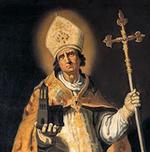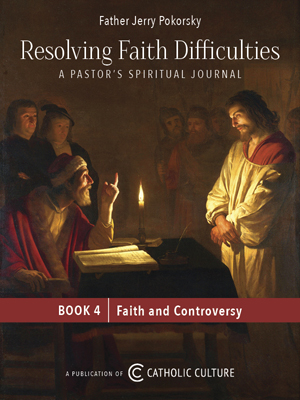The Feast of All Saints
November 1
THE FEAST of All Saints is one of the greatest of all the feasts because it celebrates what could have been impossible. The cross is a tree that bears fruit. This is the feast of its harvest. The celebrations of the mysteries in the life of Our Lord are glorious and there is no detracting from them. But He was God. This day we celebrate the perfecting of human nature, by grace pouring from the side of Christ on the cross, through His Church and His sacraments, remaking men after their despoiling in the Garden.
Aside from all the lofty things to be said about the saints and to the saints on this day, we want our children to understand in the marrow of their bones what the principal idea is: "We are so glad for you. Now pray, so we'll be there too!" And they must add to this and to every feast an endless: "Thank you, Lord Jesus, for making it possible."
Celebrating all its patrons this day, the family plans a procession to the dinner table which will show them off splendidly. If there have been saint costumes from All Hallows' Eve, nothing could be better than to wear them again in procession on All Hallows' Day. Had someone suggested this to me as a child, I would have died of joy. I remember vain attempts to recapture Halloween magic by putting on a costume a second night, but the magic was gone. Only one night of the year did it really transform me, not because the night was really magic or that I knew why I wore it, but because it was the night for costumes. There was no reason to wear it a second time. Now that we understand there is a reason, it is a great incentive to be a saint on Halloween.
A PROCESSION OF HOPEFUL SAINTS
We assemble for our procession.
St. Monica wears a veil, something black or grey, symbolic of widowhood. She may carry a monstrance with the Blessed Sacrament to tell of her devotion to the Holy Eucharist and her attendance at daily Mass (St. Augustine wrote about this in his Confessions), or she may carry a spindle, the symbol of all married ladies who were saints. The monstrance is a flat paste-up of yellow, gold, and white paper; the spindle is a stick with white cotton batting.
Jamie carries as many of the symbols of pilgrims as he can find, because St. James the Great (the tall) is always dressed as a pilgrim. His best friend gave him a key chain with little shells on it one year, for his feast day, because the scallop shell is the most common symbol of pilgrims. A staff is another, and a pilgrim's hat (broad brimmed), and a purse (like a shoulder strap bag).
John has difficulty deciding which St. John to be, but usually ends up as St. John the Baptist. One Halloween we had a charade of St. John the Baptist. A mysterious maiden came dancing in with a jack-o'-lantern on a platter--representing what? Some people are shocked to think that we would disport so, but we think it is apropos. Losing one's head for the love of God and going right to Heaven is something to grin about. A cruciform staff is one of his symbols, and the paste-up puzzle of St. John has several symbols on it (described in chapter 3). (We keep forgetting to buy a comb of honey.)
Peter rattles keys and carries the paste-up puzzle of St. Peter--or, if he can manage it, a rock--and the fishing pole with the yellow fish dangling (see chapter 18). Stephen wears a gorgeous crown made of two crowns. A high red paper crown has a smaller silver paper crown stapled over it. It is really very handsome. In this he represents St. Stephen, King and Confessor, of Hungary. He also carries a rock to show his devotion to St. Stephen, Deacon and Martyr. He always says: "This is for St. Stephen of Hungary, and this is for the St. Stephen what got rocks thrown at his head, and when I get there I'll be St. Stephen Newland."
Philip carries a basket of bread to recall that St. Philip doubted that the five thousand (not counting women and children) could be fed. That evening after the Sermon on the Mount, he literally had to eat his own words. He also carries a branch with green leaves. Although this is a little obscure, it reminds us of Philip's friend Nathaniel, sitting under the fig tree when Philip told him they had found "Him of whom Moses and the prophets spoke." It was Jesus, son of Joseph, of Nazareth, he said. Nathaniel muttered: "Can anything good come out of Nazareth?" And Philip, to his everlasting credit, answered: "Come and see."
Christopher is still to be initiated to carrying anything but his faded dolly stuffed with shredded nylons and his little ditty doggy. Perhaps this year he will get in line if we give him a flashlight, a modern counterpart of St. Christopher's lantern. Grandma Reed will carry Our Lady, because her name is Ann; Granny Newland will carry a rosary because her name is Catherine and she is a Dominican tertiary.
There are plenty of St. Williams for daddies named William but not all their stories are told in detail. The symbols of St. William of Monte Virgine are a trowel (because he built a monastery), a lily for chastity, a passion flower (to indicate that he was devoted to the Passion of Our Lord). But there is another St. William, of Perth, a Scotch saint who is mighty appealing to fathers bearing his name. He was a baker in private life, then turned his feet toward God and set out on a pilgrimage with his apprentice to do penance for his sins. Somewhere along the way the apprentice murdered him. This is not the feature that appeals to fathers. For lack of a symbol, a tray of hot rolls would do nicely, luring even the most self- conscious father into a procession. (Not all fathers go for processions. It is fatal to try to drag them in. Never use force on them or on older children who may feel it is an awkward idea. You can always think of some happy but unobtrusive way to recall the triumphs of their saints. Often just to tell their stories at dinner is enough. Your own good sense will guide you.)
The banner for the Assumption is carried by the mother in this household, because her name is Mary and she was baptized on the feast of the Assumption. It is beautiful to have each one carry a lighted candle--his baptismal candle if he has one. This to remind us that we and the saints together have life in Christ. In the Mystical Body we are all one. They are in Heaven; we are on earth; the holy souls are in Purgatory. One Church extending into eternity.
If you have enough room and time for a long procession, it is nice to sing the Litany of the Saints. If this isn't practicable, save it for night prayers.
At the last Gospel of the Mass, St. John says:
But as many as received Him, to them gave He power to become the sons of God: to them that believe in His name: who were born, not of blood, nor of the will of the flesh, nor of the will of man, but of God.
WHY WE SHOULD KNOW THE SAINTS
Each succeeding feast gives us a new understanding of this. We have been "born of God." We must know the saints because we can learn from them how to receive His will, to love it, to act on it, to use the power He has give us to become the sons of God. Here, we are His adopted sons separated from Heaven by life in the flesh. That part of us that He made in His own image and likeness is detained a while, in the body. It is being tried. The saints went through the trials too, and with the help of His grace, they overcame them. They are in glory now, sons united at last with their Father. This is the greatest of His mercies. He loved us before the creation of the world, and planned for us to be in eternity with Him. When sin spoiled the plan, He perfected it--if one can say that--with the Incarnation. He became a man and spent Himself to devise the means for our perfection. The saints used it. We must too.
The antiphon from Vespers for this feast says what we want to say:
O ye Angels and Archangels, Thrones and Dominions, Principalities and Powers, Virtues of heaven, Cherubim and Seraphim, ye Patriarchs and Prophets, holy Doctors of the Law, Apostles, all Martyrs of Christ, holy Confessors, Virgins of the Lord, Hermits and all Saints: Intercede for us.
This item 3170 digitally provided courtesy of CatholicCulture.org






